Fig. 6 -1 Growth and culturing of Bacteria
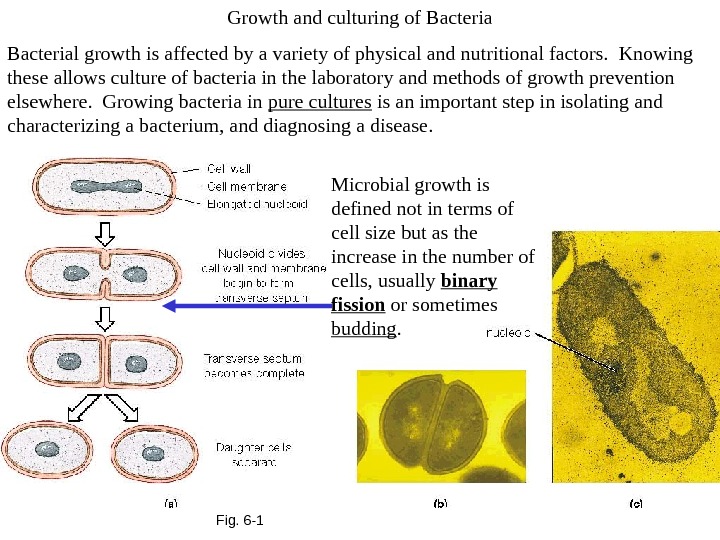
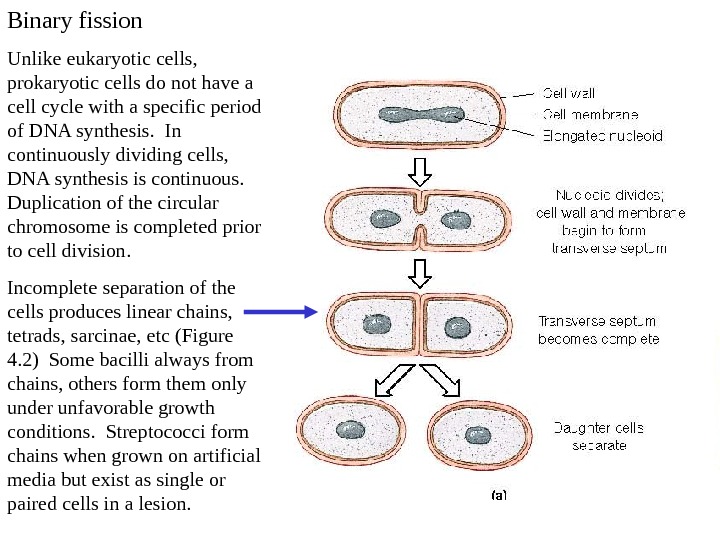

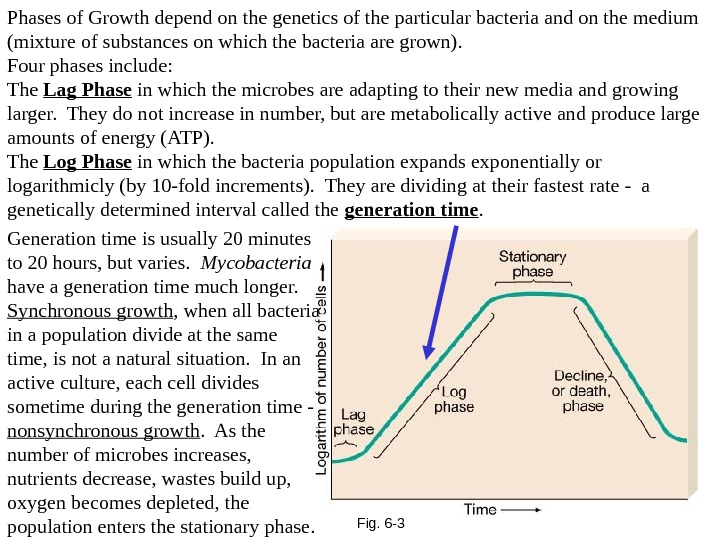

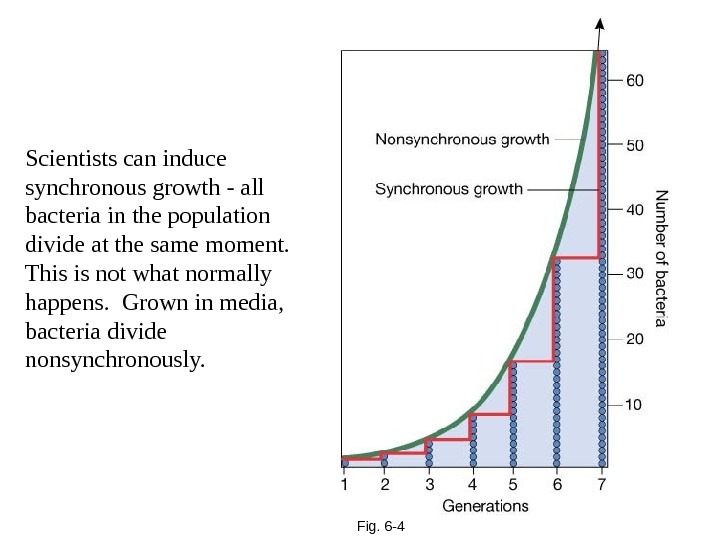




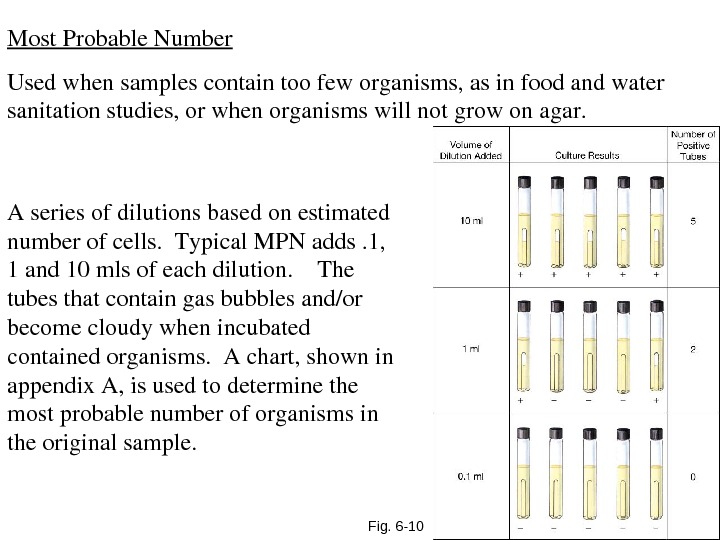
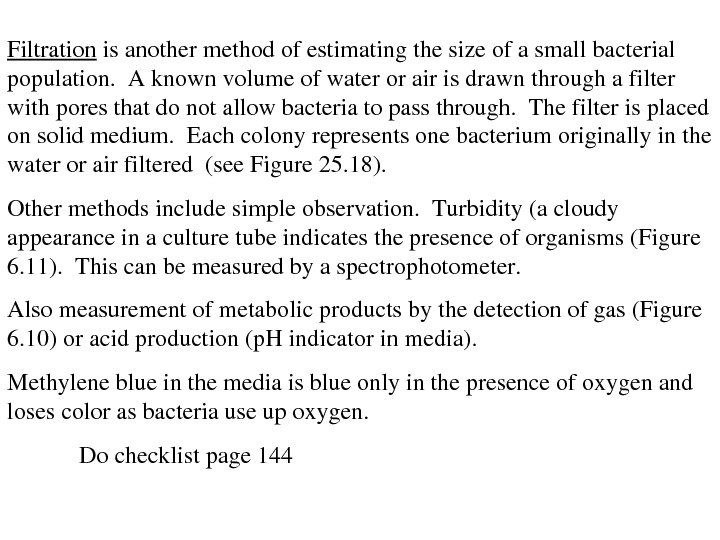
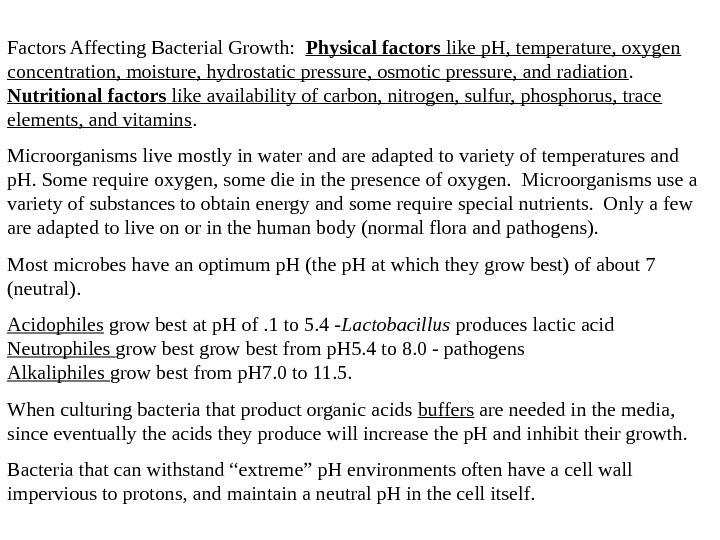
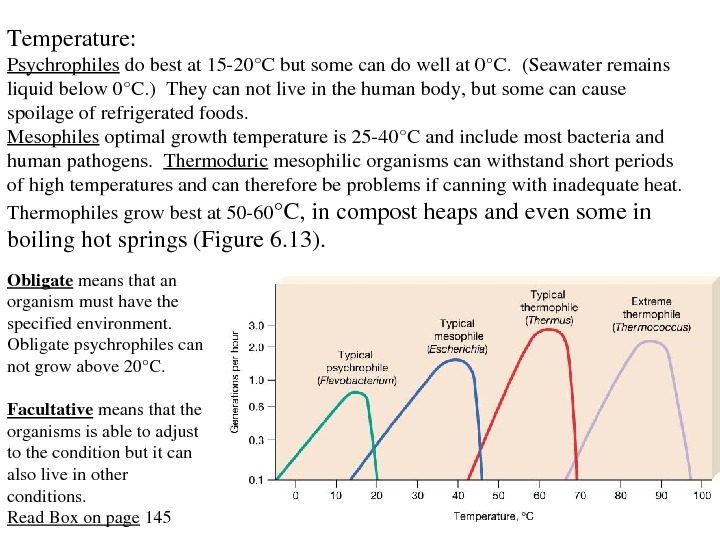

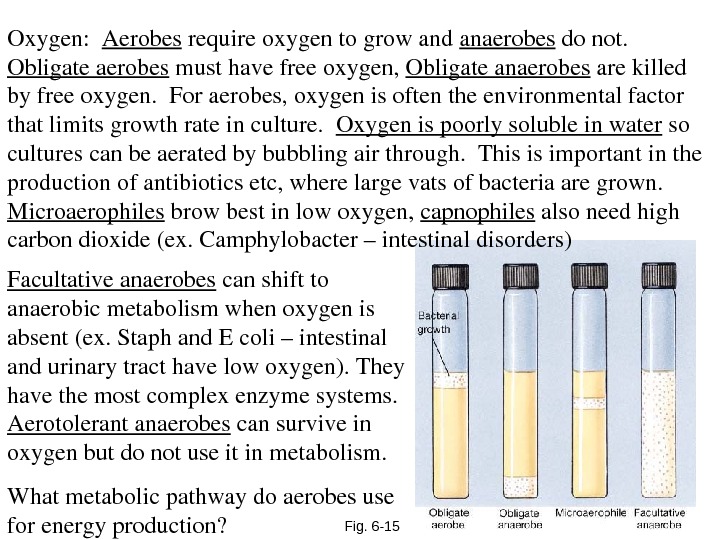

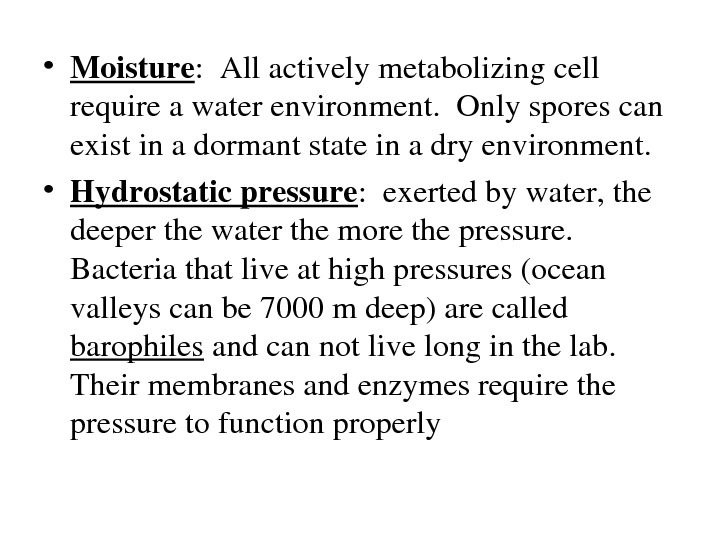

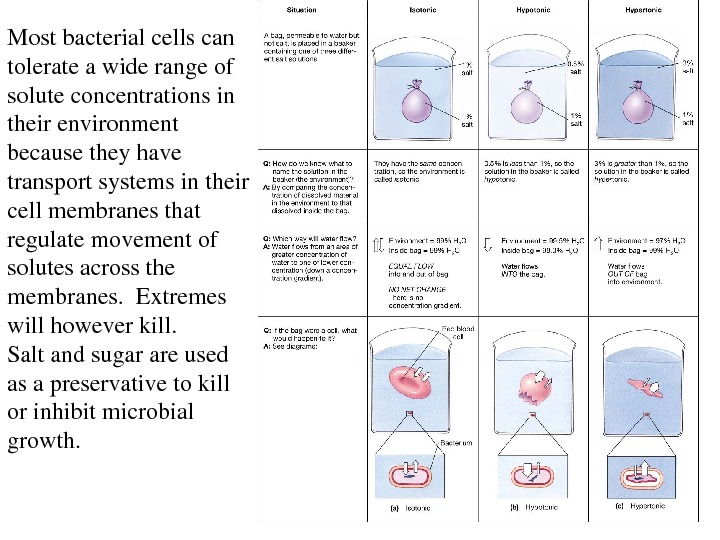
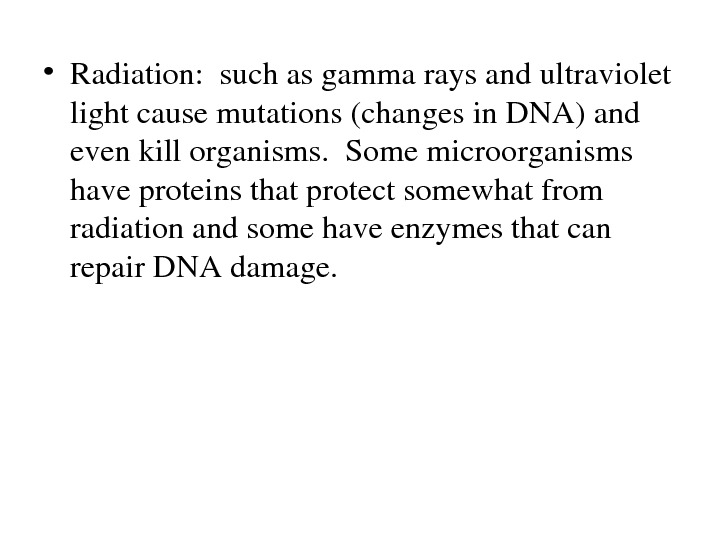

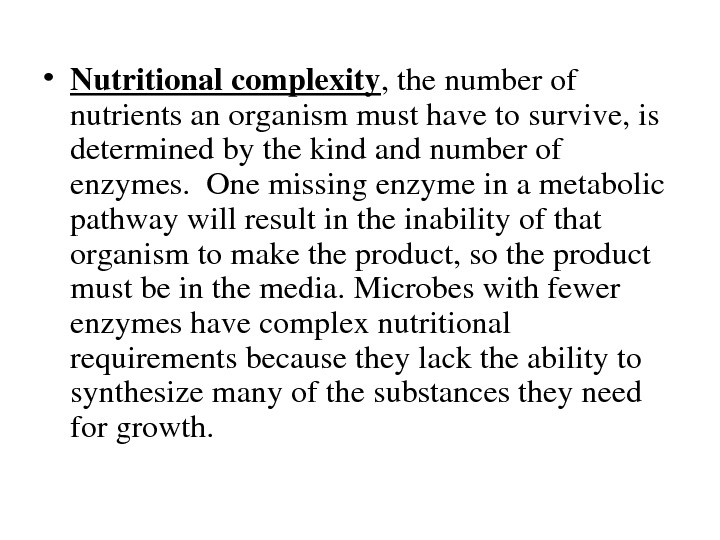

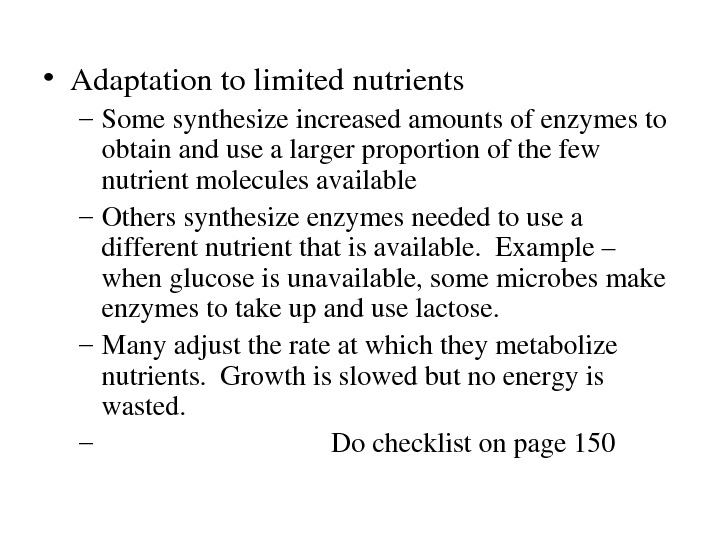


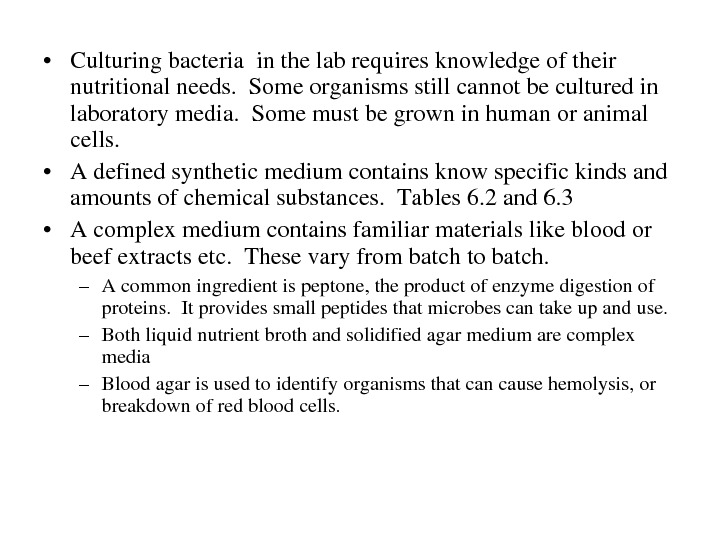

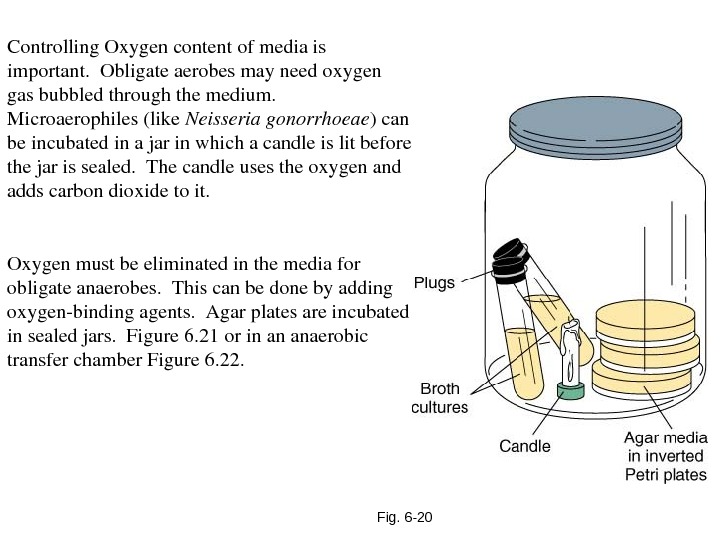

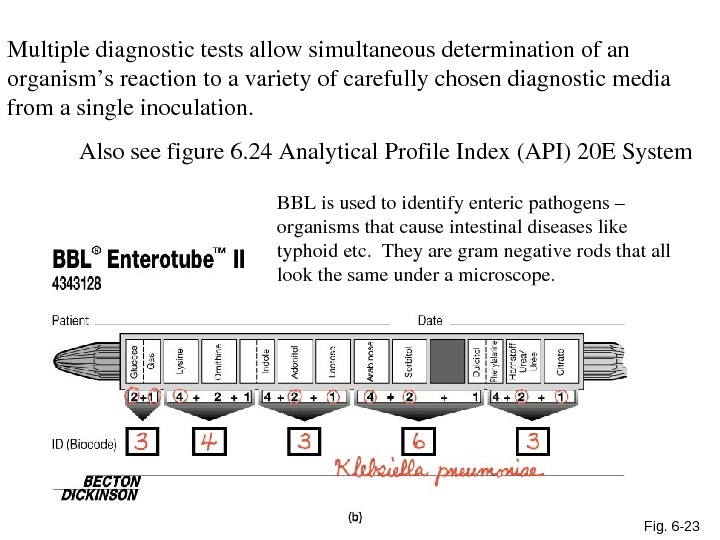
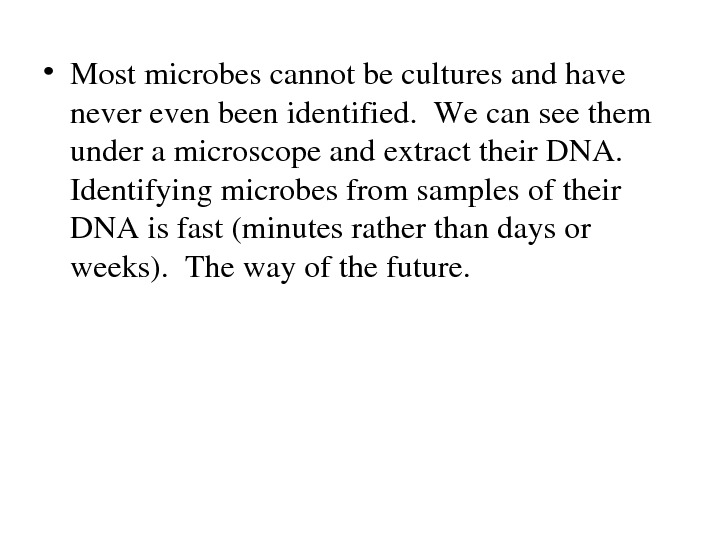
- Размер: 1.4 Mегабайта
- Количество слайдов: 33
Описание презентации Fig. 6 -1 Growth and culturing of Bacteria по слайдам
 Fig. 6 -1 Growth and culturing of Bacterial growth is affected by a variety of physical and nutritional factors. Knowing these allows culture of bacteria in the laboratory and methods of growth prevention elsewhere. Growing bacteria in pure cultures is an important step in isolating and characterizing a bacterium, and diagnosing a disease. Microbial growth is defined not in terms of cell size but as the increase in the number of cells, usually binary fission or sometimes budding.
Fig. 6 -1 Growth and culturing of Bacterial growth is affected by a variety of physical and nutritional factors. Knowing these allows culture of bacteria in the laboratory and methods of growth prevention elsewhere. Growing bacteria in pure cultures is an important step in isolating and characterizing a bacterium, and diagnosing a disease. Microbial growth is defined not in terms of cell size but as the increase in the number of cells, usually binary fission or sometimes budding.
 Binary fission Unlike eukaryotic cells, prokaryotic cells do not have a cell cycle with a specific period of DNA synthesis. In continuously dividing cells, DNA synthesis is continuous. Duplication of the circular chromosome is completed prior to cell division. Incomplete separation of the cells produces linear chains, tetrads, sarcinae, etc (Figure 4. 2) Some bacilli always from chains, others form them only under unfavorable growth conditions. Streptococci form chains when grown on artificial media but exist as single or paired cells in a lesion.
Binary fission Unlike eukaryotic cells, prokaryotic cells do not have a cell cycle with a specific period of DNA synthesis. In continuously dividing cells, DNA synthesis is continuous. Duplication of the circular chromosome is completed prior to cell division. Incomplete separation of the cells produces linear chains, tetrads, sarcinae, etc (Figure 4. 2) Some bacilli always from chains, others form them only under unfavorable growth conditions. Streptococci form chains when grown on artificial media but exist as single or paired cells in a lesion.
 Budding , in yeast and a few bacteria, is the development of a small, new cell from the surface of an existing cell. This eventually separates.
Budding , in yeast and a few bacteria, is the development of a small, new cell from the surface of an existing cell. This eventually separates.
 Fig. 6 -3 Phases of Growth depend on the genetics of the particular bacteria and on the medium (mixture of substances on which the bacteria are grown). Four phases include: The Lag Phase in which the microbes are adapting to their new media and growing larger. They do not increase in number, but are metabolically active and produce large amounts of energy (ATP). The Log Phase in which the bacteria population expands exponentially or logarithmicly (by 10 -fold increments). They are dividing at their fastest rate — a genetically determined interval called the generation time. Generation time is usually 20 minutes to 20 hours, but varies. Mycobacteria have a generation time much longer. Synchronous growth , when all bacteria in a population divide at the same time, is not a natural situation. In an active culture, each cell divides sometime during the generation time — nonsynchronous growth. As the number of microbes increases, nutrients decrease, wastes build up, oxygen becomes depleted, the population enters the stationary phase.
Fig. 6 -3 Phases of Growth depend on the genetics of the particular bacteria and on the medium (mixture of substances on which the bacteria are grown). Four phases include: The Lag Phase in which the microbes are adapting to their new media and growing larger. They do not increase in number, but are metabolically active and produce large amounts of energy (ATP). The Log Phase in which the bacteria population expands exponentially or logarithmicly (by 10 -fold increments). They are dividing at their fastest rate — a genetically determined interval called the generation time. Generation time is usually 20 minutes to 20 hours, but varies. Mycobacteria have a generation time much longer. Synchronous growth , when all bacteria in a population divide at the same time, is not a natural situation. In an active culture, each cell divides sometime during the generation time — nonsynchronous growth. As the number of microbes increases, nutrients decrease, wastes build up, oxygen becomes depleted, the population enters the stationary phase.
 As the number of microbes increases, nutrients decrease, wastes build up, oxygen becomes depleted, the population enters the S tationary Phase. During this phase the number of new cells is equal to the number of cells that die. What will happen if you add fresh media? If the media is not replenished cell division decreases to the point that new cells are more cells die and the number of live cells decreases at a logarithmic rate (X 10) — The Decline or Death Phase. Many cells undergo involution — take on various unusual shapes. This makes them hard to identify. Spore-forming organisms consist of more spores than vegetative cells. Colonies growing on a solid medium contain all phases at the same time. The colony grows rapidly at its edges and cells begin to die in the center.
As the number of microbes increases, nutrients decrease, wastes build up, oxygen becomes depleted, the population enters the S tationary Phase. During this phase the number of new cells is equal to the number of cells that die. What will happen if you add fresh media? If the media is not replenished cell division decreases to the point that new cells are more cells die and the number of live cells decreases at a logarithmic rate (X 10) — The Decline or Death Phase. Many cells undergo involution — take on various unusual shapes. This makes them hard to identify. Spore-forming organisms consist of more spores than vegetative cells. Colonies growing on a solid medium contain all phases at the same time. The colony grows rapidly at its edges and cells begin to die in the center.
 Fig. 6 -4 Scientists can induce synchronous growth — all bacteria in the population divide at the same moment. This is not what normally happens. Grown in media, bacteria divide nonsynchronously.
Fig. 6 -4 Scientists can induce synchronous growth — all bacteria in the population divide at the same moment. This is not what normally happens. Grown in media, bacteria divide nonsynchronously.
 Fig. 6 -6. . Measuring. Bacterial. Growth=numberoflive(viable)organismsper milliliter Serialdilution Dilutetheoriginalbacterial culture and standardplatecounts Transferaknownvolume ontoasolidplate(agar). Foraccuracyyoumust constantlymix!!
Fig. 6 -6. . Measuring. Bacterial. Growth=numberoflive(viable)organismsper milliliter Serialdilution Dilutetheoriginalbacterial culture and standardplatecounts Transferaknownvolume ontoasolidplate(agar). Foraccuracyyoumust constantlymix!!
 Fig. 6 -7 and standardplatecounts Transferaknownvolumeonto asolidplate(agar). Spreadplatemethod eliminatesproblemsusingthe pourplatemethodwith viabilityduetoheatdamage andthefactthatcoloniesin thepourplatemethodare smaller. Whereasinglebacteriumis depositedonanagarplate, a colonyofprogenyforms. Each originalbacteriumisa colonyformingunit(CFU). Foraccuracyyoumustmixthe cultureeachtime. Dilutionfactor= 100,
Fig. 6 -7 and standardplatecounts Transferaknownvolumeonto asolidplate(agar). Spreadplatemethod eliminatesproblemsusingthe pourplatemethodwith viabilityduetoheatdamage andthefactthatcoloniesin thepourplatemethodare smaller. Whereasinglebacteriumis depositedonanagarplate, a colonyofprogenyforms. Each originalbacteriumisa colonyformingunit(CFU). Foraccuracyyoumustmixthe cultureeachtime. Dilutionfactor= 100,
 Count. Thecoloniesunderamagnifyinglensandmultiplythenumber ofcoloniesontheplatebythedilutionfactor. EX. Theaverageofthethreeplateshereis 81. 81 X 100, 000(the dilutionfactor )=8, 100, 000 or 8. 110 6 CFU/ml Thesecountsdonotincludedeadordyingbacteriaorbacteriathatcan notgrowonthechosenmedium.
Count. Thecoloniesunderamagnifyinglensandmultiplythenumber ofcoloniesontheplatebythedilutionfactor. EX. Theaverageofthethreeplateshereis 81. 81 X 100, 000(the dilutionfactor )=8, 100, 000 or 8. 110 6 CFU/ml Thesecountsdonotincludedeadordyingbacteriaorbacteriathatcan notgrowonthechosenmedium.
 Fig. 6 -9 Direct. Microscopic. Counts–Petroff. Haussercountingchamber Aknownvolumeofbacterialsuspension isintroducedontothechamberand countedmicroscopically. Thisisaccurateonly whenthereismorethan 10 millionbacteriapermilliliterand requiresevendistribution(mixwell). Thismethoddoesnot distinguishbetweenlivinganddeadcells.
Fig. 6 -9 Direct. Microscopic. Counts–Petroff. Haussercountingchamber Aknownvolumeofbacterialsuspension isintroducedontothechamberand countedmicroscopically. Thisisaccurateonly whenthereismorethan 10 millionbacteriapermilliliterand requiresevendistribution(mixwell). Thismethoddoesnot distinguishbetweenlivinganddeadcells.
 Fig. 6 -10 Most. Probable. Number Usedwhensamplescontaintoofeworganisms, asinfoodandwater sanitationstudies, orwhenorganismswillnotgrowonagar. Aseriesofdilutionsbasedonestimated numberofcells. Typical. MPNadds. 1, 1 and 10 mlsofeachdilution. The tubesthatcontaingasbubblesand/or becomecloudywhenincubated containedorganisms. Achart, shownin appendix. A, isusedtodeterminethe mostprobablenumberoforganismsin theoriginalsample.
Fig. 6 -10 Most. Probable. Number Usedwhensamplescontaintoofeworganisms, asinfoodandwater sanitationstudies, orwhenorganismswillnotgrowonagar. Aseriesofdilutionsbasedonestimated numberofcells. Typical. MPNadds. 1, 1 and 10 mlsofeachdilution. The tubesthatcontaingasbubblesand/or becomecloudywhenincubated containedorganisms. Achart, shownin appendix. A, isusedtodeterminethe mostprobablenumberoforganismsin theoriginalsample.
 Filtration isanothermethodofestimatingthesizeofasmallbacterial population. Aknownvolumeofwaterorairisdrawnthroughafilter withporesthatdonotallowbacteriatopassthrough. Thefilterisplaced onsolidmedium. Eachcolonyrepresentsonebacteriumoriginallyinthe waterorairfiltered(see. Figure 25. 18). Othermethodsincludesimpleobservation. Turbidity(acloudy appearanceinaculturetubeindicatesthepresenceoforganisms(Figure 6. 11). Thiscanbemeasuredbyaspectrophotometer. Alsomeasurementofmetabolicproductsbythedetectionofgas(Figure 6. 10)oracidproduction(p. Hindicatorinmedia). Methyleneblueinthemediaisblueonlyinthepresenceofoxygenand losescolorasbacteriauseupoxygen. Dochecklistpage
Filtration isanothermethodofestimatingthesizeofasmallbacterial population. Aknownvolumeofwaterorairisdrawnthroughafilter withporesthatdonotallowbacteriatopassthrough. Thefilterisplaced onsolidmedium. Eachcolonyrepresentsonebacteriumoriginallyinthe waterorairfiltered(see. Figure 25. 18). Othermethodsincludesimpleobservation. Turbidity(acloudy appearanceinaculturetubeindicatesthepresenceoforganisms(Figure 6. 11). Thiscanbemeasuredbyaspectrophotometer. Alsomeasurementofmetabolicproductsbythedetectionofgas(Figure 6. 10)oracidproduction(p. Hindicatorinmedia). Methyleneblueinthemediaisblueonlyinthepresenceofoxygenand losescolorasbacteriauseupoxygen. Dochecklistpage
 Factors Affecting Bacterial Growth: Physical factors like p. H, temperature, oxygen concentration, moisture, hydrostatic pressure, osmotic pressure, and radiation. Nutritional factors like availability of carbon, nitrogen, sulfur, phosphorus, trace elements, and vitamins. Microorganisms live mostly in water and are adapted to variety of temperatures and p. H. Some require oxygen, some die in the presence of oxygen. Microorganisms use a variety of substances to obtain energy and some require special nutrients. Only a few are adapted to live on or in the human body (normal flora and pathogens). Most microbes have an optimum p. H (the p. H at which they grow best) of about 7 (neutral). Acidophiles grow best at p. H of. 1 to 5. 4 — Lactobacillus produces lactic acid Neutrophiles grow best from p. H 5. 4 to 8. 0 — pathogens Alkaliphiles grow best from p. H 7. 0 to 11. 5. When culturing bacteria that product organic acids buffers are needed in the media, since eventually the acids they produce will increase the p. H and inhibit their growth. Bacteria that can withstand “extreme” p. H environments often have a cell wall impervious to protons, and maintain a neutral p. H in the cell itself.
Factors Affecting Bacterial Growth: Physical factors like p. H, temperature, oxygen concentration, moisture, hydrostatic pressure, osmotic pressure, and radiation. Nutritional factors like availability of carbon, nitrogen, sulfur, phosphorus, trace elements, and vitamins. Microorganisms live mostly in water and are adapted to variety of temperatures and p. H. Some require oxygen, some die in the presence of oxygen. Microorganisms use a variety of substances to obtain energy and some require special nutrients. Only a few are adapted to live on or in the human body (normal flora and pathogens). Most microbes have an optimum p. H (the p. H at which they grow best) of about 7 (neutral). Acidophiles grow best at p. H of. 1 to 5. 4 — Lactobacillus produces lactic acid Neutrophiles grow best from p. H 5. 4 to 8. 0 — pathogens Alkaliphiles grow best from p. H 7. 0 to 11. 5. When culturing bacteria that product organic acids buffers are needed in the media, since eventually the acids they produce will increase the p. H and inhibit their growth. Bacteria that can withstand “extreme” p. H environments often have a cell wall impervious to protons, and maintain a neutral p. H in the cell itself.
 Temperature: Psychrophiles dobestat 1520°Cbutsomecandowellat 0°C. (Seawaterremains liquidbelow 0 °C. )Theycannotliveinthehumanbody, butsomecancause spoilageofrefrigeratedfoods. Mesophiles optimalgrowthtemperatureis 2540 °Candincludemostbacteriaand humanpathogens. Thermoduric mesophilicorganismscanwithstandshortperiods ofhightemperaturesandcanthereforebeproblemsifcanningwithinadequateheat. Thermophilesgrowbestat 5060 ° C, incompostheapsandevensomein boilinghotsprings(Figure 6. 13). Obligate meansthatan organismmusthavethe specifiedenvironment. Obligatepsychrophilescan notgrowabove 20 °C. Facultative meansthatthe organismsisabletoadjust totheconditionbutitcan alsoliveinother conditions. Read. Boxonpage
Temperature: Psychrophiles dobestat 1520°Cbutsomecandowellat 0°C. (Seawaterremains liquidbelow 0 °C. )Theycannotliveinthehumanbody, butsomecancause spoilageofrefrigeratedfoods. Mesophiles optimalgrowthtemperatureis 2540 °Candincludemostbacteriaand humanpathogens. Thermoduric mesophilicorganismscanwithstandshortperiods ofhightemperaturesandcanthereforebeproblemsifcanningwithinadequateheat. Thermophilesgrowbestat 5060 ° C, incompostheapsandevensomein boilinghotsprings(Figure 6. 13). Obligate meansthatan organismmusthavethe specifiedenvironment. Obligatepsychrophilescan notgrowabove 20 °C. Facultative meansthatthe organismsisabletoadjust totheconditionbutitcan alsoliveinother conditions. Read. Boxonpage
 • Thetemperaturerangeofanorganismsisdetermined largelybyitsenzymes. Theoptimumtemperatureis oftenverynearthemaximumtemperature. Thesharp decreaseinenzymeactivityatatemperatureonly slightlyhigherthantheoptimumoccursasenzyme moleculesaredenatured. Temperatureisimportantin growingbacteriaandininhibiting theirgrowth. Foodisrefrigerated toreducethegrowthof psychrophilesandpreventthe growthofmostotherbacteria. Freezing(bloodalso)isbestfor longtermstorage. Heatingis usedtosterilizeandpreserve. Enzymescanrenatureafter freezing, butnotafterexcessive heat.
• Thetemperaturerangeofanorganismsisdetermined largelybyitsenzymes. Theoptimumtemperatureis oftenverynearthemaximumtemperature. Thesharp decreaseinenzymeactivityatatemperatureonly slightlyhigherthantheoptimumoccursasenzyme moleculesaredenatured. Temperatureisimportantin growingbacteriaandininhibiting theirgrowth. Foodisrefrigerated toreducethegrowthof psychrophilesandpreventthe growthofmostotherbacteria. Freezing(bloodalso)isbestfor longtermstorage. Heatingis usedtosterilizeandpreserve. Enzymescanrenatureafter freezing, butnotafterexcessive heat.
 Fig. 6 -15 Oxygen: Aerobes requireoxygentogrowand anaerobes donot. Obligateaerobes musthavefreeoxygen, Obligateanaerobes arekilled byfreeoxygen. Foraerobes, oxygenisoftentheenvironmentalfactor thatlimitsgrowthrateinculture. Oxygenispoorlysolubleinwater so culturescanbeaeratedbybubblingairthrough. Thisisimportantinthe productionofantibioticsetc, wherelargevatsofbacteriaaregrown. Microaerophiles browbestinlowoxygen, capnophiles alsoneedhigh carbondioxide(ex. Camphylobacter–intestinaldisorders) Facultativeanaerobes canshiftto anaerobicmetabolismwhenoxygenis absent(ex. Staphand. Ecoli–intestinal andurinarytracthavelowoxygen). They havethemostcomplexenzymesystems. Aerotolerantanaerobes cansurvivein oxygenbutdonotuseitinmetabolism. Whatmetabolicpathwaydoaerobesuse forenergyproduction?
Fig. 6 -15 Oxygen: Aerobes requireoxygentogrowand anaerobes donot. Obligateaerobes musthavefreeoxygen, Obligateanaerobes arekilled byfreeoxygen. Foraerobes, oxygenisoftentheenvironmentalfactor thatlimitsgrowthrateinculture. Oxygenispoorlysolubleinwater so culturescanbeaeratedbybubblingairthrough. Thisisimportantinthe productionofantibioticsetc, wherelargevatsofbacteriaaregrown. Microaerophiles browbestinlowoxygen, capnophiles alsoneedhigh carbondioxide(ex. Camphylobacter–intestinaldisorders) Facultativeanaerobes canshiftto anaerobicmetabolismwhenoxygenis absent(ex. Staphand. Ecoli–intestinal andurinarytracthavelowoxygen). They havethemostcomplexenzymesystems. Aerotolerantanaerobes cansurvivein oxygenbutdonotuseitinmetabolism. Whatmetabolicpathwaydoaerobesuse forenergyproduction?
 • Obligateanaerobesarekilledbythehighly reactiveandtoxicforofoxygensuperoxide, whichisformedbyoxidativeenzymes. • Toprotectanycellsuperoxidemustbe convertedtooxygenandhydrogenperoxide by superoxidedismutase andthenhydrogen peroxidetowaterandoxygenby catalase. • Obligateanaerobesusuallylackbothenzymes.
• Obligateanaerobesarekilledbythehighly reactiveandtoxicforofoxygensuperoxide, whichisformedbyoxidativeenzymes. • Toprotectanycellsuperoxidemustbe convertedtooxygenandhydrogenperoxide by superoxidedismutase andthenhydrogen peroxidetowaterandoxygenby catalase. • Obligateanaerobesusuallylackbothenzymes.
 • Moisture : Allactivelymetabolizingcell requireawaterenvironment. Onlysporescan existinadormantstateinadryenvironment. • Hydrostaticpressure : exertedbywater, the deeperthewaterthemorethepressure. Bacteriathatliveathighpressures(ocean valleyscanbe 7000 mdeep)arecalled barophiles andcannotlivelonginthelab. Theirmembranesandenzymesrequirethe pressuretofunctionproperly
• Moisture : Allactivelymetabolizingcell requireawaterenvironment. Onlysporescan existinadormantstateinadryenvironment. • Hydrostaticpressure : exertedbywater, the deeperthewaterthemorethepressure. Bacteriathatliveathighpressures(ocean valleyscanbe 7000 mdeep)arecalled barophiles andcannotlivelonginthelab. Theirmembranesandenzymesrequirethe pressuretofunctionproperly
 • Osmoticpressure : Environmentsthatcontain dissolvedsubstancesexert osmoticpressure. The pressureoutsideofacell canexceedthepressurein thecell. Thesebacteriaare ina hyperosmotic environmentandwilllose waterandundergo plasmolysis , shrinking. The cellmembraneseparates fromthecellwall.
• Osmoticpressure : Environmentsthatcontain dissolvedsubstancesexert osmoticpressure. The pressureoutsideofacell canexceedthepressurein thecell. Thesebacteriaare ina hyperosmotic environmentandwilllose waterandundergo plasmolysis , shrinking. The cellmembraneseparates fromthecellwall.
 Mostbacterialcellscan tolerateawiderangeof soluteconcentrationsin theirenvironment becausetheyhave transportsystemsintheir cellmembranesthat regulatemovementof solutesacrossthe membranes. Extremes willhoweverkill. Saltandsugarareused asapreservativetokill orinhibitmicrobial growth.
Mostbacterialcellscan tolerateawiderangeof soluteconcentrationsin theirenvironment becausetheyhave transportsystemsintheir cellmembranesthat regulatemovementof solutesacrossthe membranes. Extremes willhoweverkill. Saltandsugarareused asapreservativetokill orinhibitmicrobial growth.
 • Radiation: suchasgammaraysandultraviolet lightcausemutations(changesin. DNA)and evenkillorganisms. Somemicroorganisms haveproteinsthatprotectsomewhatfrom radiationandsomehaveenzymesthatcan repair. DNAdamage.
• Radiation: suchasgammaraysandultraviolet lightcausemutations(changesin. DNA)and evenkillorganisms. Somemicroorganisms haveproteinsthatprotectsomewhatfrom radiationandsomehaveenzymesthatcan repair. DNAdamage.
 • Nutritional. Factors – Carbonsources –Photoautotrophicorganismsreducecarbondioxideto glucoseetc. Bothautotrophicandheterotrophicorganismscanget energyfromglucosebyglycolysis, fermentation, andthe. Krebscycle. – Nitrogensource –Allneednitrogentosynthesizeenzymes(proteins) andnucleicacids. Why? Someuseinorganicnitrogen, othersrequire nitrogencontainingorganicmolecules. Somecansynthesizeallamino acids, otherscannot. Fastidiousorganismsrequireall 20 aminoacidsin theirmedium. Why? – Sulfurandphosphorus –frominorganicphosphateions/sulfatesaltsor fromsulfurcontainingaminoacids. – Traceelements –likeiron, zinc, etcareoften cofactors inenzymatic reactions. Example, ironisrequiredforthesynthesisofhemcontaining compoundsimportantintheelectrontransportchainofoxidative phosphorylation. Althoughlittleisrequired, ashortageseverelyretards growth. Toomuchironinourbloodsupportsbacterialgrowth. – Vitamins –areorganicsubstancesthatanorganismrequiresinsmall amounts. Theseare coenzymes. Somemicrobesmakethereown, but othersrequirethesevitaminsinthemediasincetheylacktheenzymesto producethem. • Microbeslivinginthehumanintestinesmakevitamin. K, necessaryfor bloodclotting.
• Nutritional. Factors – Carbonsources –Photoautotrophicorganismsreducecarbondioxideto glucoseetc. Bothautotrophicandheterotrophicorganismscanget energyfromglucosebyglycolysis, fermentation, andthe. Krebscycle. – Nitrogensource –Allneednitrogentosynthesizeenzymes(proteins) andnucleicacids. Why? Someuseinorganicnitrogen, othersrequire nitrogencontainingorganicmolecules. Somecansynthesizeallamino acids, otherscannot. Fastidiousorganismsrequireall 20 aminoacidsin theirmedium. Why? – Sulfurandphosphorus –frominorganicphosphateions/sulfatesaltsor fromsulfurcontainingaminoacids. – Traceelements –likeiron, zinc, etcareoften cofactors inenzymatic reactions. Example, ironisrequiredforthesynthesisofhemcontaining compoundsimportantintheelectrontransportchainofoxidative phosphorylation. Althoughlittleisrequired, ashortageseverelyretards growth. Toomuchironinourbloodsupportsbacterialgrowth. – Vitamins –areorganicsubstancesthatanorganismrequiresinsmall amounts. Theseare coenzymes. Somemicrobesmakethereown, but othersrequirethesevitaminsinthemediasincetheylacktheenzymesto producethem. • Microbeslivinginthehumanintestinesmakevitamin. K, necessaryfor bloodclotting.
 • Nutritionalcomplexity , thenumberof nutrientsanorganismmusthavetosurvive, is determinedbythekindandnumberof enzymes. Onemissingenzymeinametabolic pathwaywillresultintheinabilityofthat organismtomaketheproduct, sotheproduct mustbeinthemedia. Microbeswithfewer enzymeshavecomplexnutritional requirementsbecausetheylacktheabilityto synthesizemanyofthesubstancestheyneed forgrowth.
• Nutritionalcomplexity , thenumberof nutrientsanorganismmusthavetosurvive, is determinedbythekindandnumberof enzymes. Onemissingenzymeinametabolic pathwaywillresultintheinabilityofthat organismtomaketheproduct, sotheproduct mustbeinthemedia. Microbeswithfewer enzymeshavecomplexnutritional requirementsbecausetheylacktheabilityto synthesizemanyofthesubstancestheyneed forgrowth.
 • Locationof. Enzymes – Endoenzymes , theusual, insidethecell – Exoenzymes arereleasedthroughthecell membrane(hydrolaseswhichsplitlargemolecules ofcarbohydrate, lipid, orproteinintosmallerones thatcanbetakenintothecell). • Extracellularenzymes producedbygrampositiverods, whichactinthemediasurroundingthecell • Periplasmicenzymes producedbygramnegative organismswhichactintheperiplasmicspace
• Locationof. Enzymes – Endoenzymes , theusual, insidethecell – Exoenzymes arereleasedthroughthecell membrane(hydrolaseswhichsplitlargemolecules ofcarbohydrate, lipid, orproteinintosmallerones thatcanbetakenintothecell). • Extracellularenzymes producedbygrampositiverods, whichactinthemediasurroundingthecell • Periplasmicenzymes producedbygramnegative organismswhichactintheperiplasmicspace
 • Adaptationtolimitednutrients – Somesynthesizeincreasedamountsofenzymesto obtainandusealargerproportionofthefew nutrientmoleculesavailable – Otherssynthesizeenzymesneededtousea differentnutrientthatisavailable. Example– whenglucoseisunavailable, somemicrobesmake enzymestotakeupanduselactose. – Manyadjusttherateatwhichtheymetabolize nutrients. Growthisslowedbutnoenergyis wasted. – Dochecklistonpage
• Adaptationtolimitednutrients – Somesynthesizeincreasedamountsofenzymesto obtainandusealargerproportionofthefew nutrientmoleculesavailable – Otherssynthesizeenzymesneededtousea differentnutrientthatisavailable. Example– whenglucoseisunavailable, somemicrobesmake enzymestotakeupanduselactose. – Manyadjusttherateatwhichtheymetabolize nutrients. Growthisslowedbutnoenergyis wasted. – Dochecklistonpage
 Fig. 6 -17 Sporulation, theformationofendospores, occursin Bacillus , Clostridium , etc. See. Figure 6. 18 Bacteriathatformendosporesdosoatalowfrequencywhennutrients areavailable, moreoftenwhennutrientsarescarse. DNAisreplicated Celldoesnotdivide RNA, protein neededfor “life” Cellmembrane Peptidoglycan between membranes Endosporesknown tobe 300 yrsold germinate!!
Fig. 6 -17 Sporulation, theformationofendospores, occursin Bacillus , Clostridium , etc. See. Figure 6. 18 Bacteriathatformendosporesdosoatalowfrequencywhennutrients areavailable, moreoftenwhennutrientsarescarse. DNAisreplicated Celldoesnotdivide RNA, protein neededfor “life” Cellmembrane Peptidoglycan between membranes Endosporesknown tobe 300 yrsold germinate!!
 Apurecultureofasinglespeciesisneededtostudyit’scharacteristics andamediummustbefoundthatwillsupportit’sgrowth. Aseptic(sterile)techniqueisimportanttoensurethattheculture remainspure–onlyonespecies Streak. Plate. Method Pour. Plate. Method
Apurecultureofasinglespeciesisneededtostudyit’scharacteristics andamediummustbefoundthatwillsupportit’sgrowth. Aseptic(sterile)techniqueisimportanttoensurethattheculture remainspure–onlyonespecies Streak. Plate. Method Pour. Plate. Method
 • Culturingbacteriainthelabrequiresknowledgeoftheir nutritionalneeds. Someorganismsstillcannotbeculturedin laboratorymedia. Somemustbegrowninhumanoranimal cells. • Adefinedsyntheticmediumcontainsknowspecifickindsand amountsofchemicalsubstances. Tables 6. 2 and 6. 3 • Acomplexmediumcontainsfamiliarmaterialslikebloodor beefextractsetc. Thesevaryfrombatchtobatch. – Acommoningredientispeptone, theproductofenzymedigestionof proteins. Itprovidessmallpeptidesthatmicrobescantakeupanduse. – Bothliquidnutrientbrothandsolidifiedagarmediumarecomplex media – Bloodagarisusedtoidentifyorganismsthatcancausehemolysis, or breakdownofredbloodcells.
• Culturingbacteriainthelabrequiresknowledgeoftheir nutritionalneeds. Someorganismsstillcannotbeculturedin laboratorymedia. Somemustbegrowninhumanoranimal cells. • Adefinedsyntheticmediumcontainsknowspecifickindsand amountsofchemicalsubstances. Tables 6. 2 and 6. 3 • Acomplexmediumcontainsfamiliarmaterialslikebloodor beefextractsetc. Thesevaryfrombatchtobatch. – Acommoningredientispeptone, theproductofenzymedigestionof proteins. Itprovidessmallpeptidesthatmicrobescantakeupanduse. – Bothliquidnutrientbrothandsolidifiedagarmediumarecomplex media – Bloodagarisusedtoidentifyorganismsthatcancausehemolysis, or breakdownofredbloodcells.
 • Mediausedtoisolateandidentifyparticularmicroorganisms, frompatientswithinfectiousdiseases, areselective, differential, orenrichmentmedia. Table 6. 5 – Selective mediaencouragesthegrowthofsomeorganismsbut suppressesthegrowthofothers. • Ex. Toidentify Clostridiumbotulinum infood, antibioticssulfiazineand polymyxinsulfate(SPS)areaddedtoanaerobiccultures. SPSinhibits other Clostridium species. – Differential mediacontainssomethingthatcausesacolorchange whenaparticularchemicalreactionoccurstodistinguishacertaintype ofcolony. • Ex. Coloniesof. Cbotulinumareblackon SPSmedia • Mac. Conkeyagar isalsobothselectiveanddifferential. See. Table 6. 5 – Enrichmentmediaallowsparticularmicroorganismsthatmightother wisebetoofewtoculturetogrowbetter. Toincreasethechanceof identifyingitinasample– Salmonellatyphi infecalsample.
• Mediausedtoisolateandidentifyparticularmicroorganisms, frompatientswithinfectiousdiseases, areselective, differential, orenrichmentmedia. Table 6. 5 – Selective mediaencouragesthegrowthofsomeorganismsbut suppressesthegrowthofothers. • Ex. Toidentify Clostridiumbotulinum infood, antibioticssulfiazineand polymyxinsulfate(SPS)areaddedtoanaerobiccultures. SPSinhibits other Clostridium species. – Differential mediacontainssomethingthatcausesacolorchange whenaparticularchemicalreactionoccurstodistinguishacertaintype ofcolony. • Ex. Coloniesof. Cbotulinumareblackon SPSmedia • Mac. Conkeyagar isalsobothselectiveanddifferential. See. Table 6. 5 – Enrichmentmediaallowsparticularmicroorganismsthatmightother wisebetoofewtoculturetogrowbetter. Toincreasethechanceof identifyingitinasample– Salmonellatyphi infecalsample.
 Fig. 6 -20 Controlling. Oxygencontentofmediais important. Obligateaerobesmayneedoxygen gasbubbledthroughthemedium. Microaerophiles(like Neisseriagonorrhoeae )can beincubatedinajarinwhichacandleislitbefore thejarissealed. Thecandleusestheoxygenand addscarbondioxidetoit. Oxygenmustbeeliminatedinthemediafor obligateanaerobes. Thiscanbedonebyadding oxygenbindingagents. Agarplatesareincubated insealedjars. Figure 6. 21 orinananaerobic transferchamber. Figure 6. 22.
Fig. 6 -20 Controlling. Oxygencontentofmediais important. Obligateaerobesmayneedoxygen gasbubbledthroughthemedium. Microaerophiles(like Neisseriagonorrhoeae )can beincubatedinajarinwhichacandleislitbefore thejarissealed. Thecandleusestheoxygenand addscarbondioxidetoit. Oxygenmustbeeliminatedinthemediafor obligateanaerobes. Thiscanbedonebyadding oxygenbindingagents. Agarplatesareincubated insealedjars. Figure 6. 21 orinananaerobic transferchamber. Figure 6. 22.
 • Maintainingcultures – Maintainedindefinitelyinapureculturecalleda stockculture • Bymakingsubculturesinfreshmediumusingaseptic techniques. • Alwaysdangerofcontaminationandmutationswhich canalterthecharacteristicsofthebacteria. – Toavoidtheriskofcontaminationormutation, a preservedculture iskept • By lyophilization (freezedrying) • Areferenceculturelikethisisusedtocheckbackon thecharacteristicsofthebacteria. Allaremaintainedin the. American. Type. Culture. Collection. Dochecklistonpage
• Maintainingcultures – Maintainedindefinitelyinapureculturecalleda stockculture • Bymakingsubculturesinfreshmediumusingaseptic techniques. • Alwaysdangerofcontaminationandmutationswhich canalterthecharacteristicsofthebacteria. – Toavoidtheriskofcontaminationormutation, a preservedculture iskept • By lyophilization (freezedrying) • Areferenceculturelikethisisusedtocheckbackon thecharacteristicsofthebacteria. Allaremaintainedin the. American. Type. Culture. Collection. Dochecklistonpage
 Fig. 6 -23 Multiplediagnostictestsallowsimultaneousdeterminationofan organism’sreactiontoavarietyofcarefullychosendiagnosticmedia fromasingleinoculation. Alsoseefigure 6. 24 Analytical. Profile. Index(API)20 ESystem BBLisusedtoidentifyentericpathogens– organismsthatcauseintestinaldiseaseslike typhoidetc. Theyaregramnegativerodsthatall lookthesameunderamicroscope.
Fig. 6 -23 Multiplediagnostictestsallowsimultaneousdeterminationofan organism’sreactiontoavarietyofcarefullychosendiagnosticmedia fromasingleinoculation. Alsoseefigure 6. 24 Analytical. Profile. Index(API)20 ESystem BBLisusedtoidentifyentericpathogens– organismsthatcauseintestinaldiseaseslike typhoidetc. Theyaregramnegativerodsthatall lookthesameunderamicroscope.
 • Mostmicrobescannotbeculturesandhave neverevenbeenidentified. Wecanseethem underamicroscopeandextracttheir. DNA. Identifyingmicrobesfromsamplesoftheir DNAisfast(minutesratherthandaysor weeks). Thewayofthefuture.
• Mostmicrobescannotbeculturesandhave neverevenbeenidentified. Wecanseethem underamicroscopeandextracttheir. DNA. Identifyingmicrobesfromsamplesoftheir DNAisfast(minutesratherthandaysor weeks). Thewayofthefuture.
